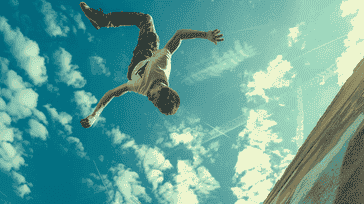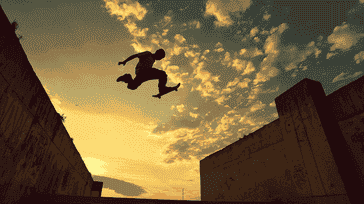Parkour Philosophy: Embracing Creativity and Adaptability in Movement

What is Parkour?
Parkour, also known as "lart du déplacement," is a discipline that involves moving through obstacles in the most efficient and fluid way possible. Originating from France in the late 1980s, parkour is more than just an extreme sport; its a way of life. Parkour practitioners, called traceurs, navigate their surroundings by using their bodies efficiently and creatively, combining elements of running, jumping, climbing, and rolling. The essence of parkour lies in the philosophy of overcoming physical and mental barriers, embracing creativity, and adapting to any environment.
History and Origins of Parkour

Parkour traces its roots back to the suburbs of Paris, where a group of young individuals developed a unique approach to movement. The father of parkour, David Belle, drew inspiration from his father, who served in the French military and taught him the importance of physical and mental discipline. David and his friends, known as the Yamakasi, began training in the late 1980s, refining their techniques and spreading the philosophy of parkour. Over time, parkour gained popularity worldwide, becoming an art form that transcends cultural boundaries.
The Philosophy Behind Parkour
At its core, parkour is not just about performing impressive stunts or seeking adrenaline rushes. It is a philosophy that promotes self-improvement, resilience, and personal growth. Parkour teaches individuals to overcome fear, break through mental barriers, and develop a deep sense of self-awareness. It encourages practitioners to see their environment as a playground, constantly challenging themselves to find new paths and solutions. The philosophy of parkour extends beyond physical movement, emphasizing adaptability, problem-solving, and a positive mindset in all aspects of life.
Benefits of Practicing Parkour

Engaging in parkour offers a myriad of benefits for both the body and mind. Physically, parkour is an intense full-body workout that improves strength, agility, and flexibility. It enhances cardiovascular endurance and boosts overall fitness levels. Mentally, parkour cultivates mental resilience, as traceurs learn to conquer fear, overcome obstacles, and think quickly on their feet. Parkour also fosters spatial awareness, coordination, and balance, which can be transferred to other activities and sports. Additionally, parkour provides a sense of accomplishment and empowerment, boosting self-confidence and self-esteem.
Parkour vs. Freerunning: Understanding the Difference
Parkour and freerunning are often used interchangeably, but they are distinct disciplines with subtle differences. While both involve moving through obstacles, parkour focuses on efficient and practical movement. It emphasizes speed, precision, and functionality, with the goal of reaching the destination as quickly as possible. Freerunning, on the other hand, incorporates more acrobatic and expressive movements. It allows for more creativity and self-expression, incorporating flips, spins, and stylish tricks into the movement. While parkour and freerunning share the same foundation, they diverge in their approach and purpose.
Parkour Training Essentials

To excel in parkour, certain training essentials are crucial. Firstly, developing strength and conditioning is vital to perform the demanding movements involved in parkour. Regular strength training exercises, such as bodyweight exercises and weightlifting, can build the necessary muscle power and endurance. Secondly, flexibility and mobility training are essential to move fluidly through various obstacles. Stretching routines and mobility drills help prevent injuries and improve range of motion. Lastly, practicing parkour techniques and movements, such as precision jumps, vaults, and rolls, is crucial to hone skills and improve efficiency.
Tips for Beginners in Parkour
Starting parkour can be intimidating, but with the right mindset and approach, anyone can begin their journey. Here are some tips for beginners:
- Start with the basics: Begin with simple movements like jumps, rolls, and balance exercises. Mastering the fundamentals will provide a solid foundation for more advanced techniques.
- Find a supportive community: Join a local parkour group or connect with fellow traceurs online. Learning from experienced practitioners and having a supportive community can greatly accelerate progress.
- Focus on safety: Prioritize safety by wearing appropriate gear, such as comfortable athletic shoes and protective padding. Start with low-risk environments and gradually progress to more challenging spaces.
- Take it slow: Parkour is a long-term journey, so dont rush the learning process. Listen to your body, rest when needed, and gradually increase the difficulty of movements.
- Embrace failure: Parkour is all about pushing your limits and learning from mistakes. Embrace failure as an opportunity to grow, adapt, and improve your skills.
Parkour Safety and Injury Prevention
While parkour is an exhilarating activity, safety should always be a top priority. To minimize the risk of injuries, traceurs should follow these safety guidelines:
- Warm-up and stretch: Always start your training sessions with a thorough warm-up to prepare your muscles and joints for the demands of parkour. Incorporate dynamic stretches to improve flexibility and prevent strains.
- Assess your surroundings: Before attempting any movements, carefully assess the environment for potential hazards or obstacles that could pose a risk. Be aware of slippery surfaces, loose objects, or uneven terrain.
- Progress gradually: Avoid attempting advanced movements before mastering the basics. Progress slowly, gradually increasing the difficulty and complexity of movements to prevent overexertion and injury.
- Use proper technique: Focus on proper form and technique to minimize the impact on your joints and reduce the risk of sprains or strains. Seek guidance from experienced traceurs or consider taking parkour lessons to learn the correct techniques.
- Listen to your body: Pay attention to any discomfort or pain during training. If you experience persistent pain or injuries, seek medical attention and give your body time to heal before resuming training.
Parkour Events and Competitions
Parkour has evolved into a competitive sport, with numerous events and competitions held worldwide. These events showcase the incredible skills and creativity of traceurs, providing a platform for them to demonstrate their talent. Competitions often feature various categories, such as speed runs, style runs, and freestyle performances. These events not only foster healthy competition but also serve as opportunities for traceurs to connect, learn from one another, and inspire the next generation of practitioners.
Parkour Communities and Resources
The parkour community is vibrant and supportive, with numerous resources available for traceurs of all levels. Online platforms, such as forums, social media groups, and video-sharing websites, offer a wealth of tutorials, training tips, and inspiration. Local parkour communities also provide opportunities for workshops, training sessions, and gatherings. Connecting with fellow traceurs and experienced practitioners is invaluable for learning new skills, receiving feedback, and staying motivated on the parkour journey.
Parkour as a Form of Self-Expression
Beyond the physicality of parkour, it is a powerful means of self-expression. Each traceur brings their unique style, creativity, and personality to their movements. Parkour allows individuals to explore their limits, express themselves artistically, and break free from societal constraints. Through movements that flow effortlessly, traceurs communicate their emotions, thoughts, and stories. Parkour becomes a form of art, a language without words, connecting people across cultures and inspiring others to embrace their own creativity.
Parkour and Mental Resilience
Parkour is not just about physical strength and agility; it also cultivates mental resilience. Overcoming obstacles, both physical and mental, requires determination, focus, and adaptability. Traceurs learn to face their fears, push through discomfort, and persevere in the face of challenges. The mental resilience developed through parkour transcends into everyday life, equipping practitioners with the mindset to tackle obstacles and setbacks with confidence and resilience.
Parkour in Popular Culture
Parkour has gained significant visibility in popular culture, appearing in movies, commercials, and video games. Its dynamic and visually captivating movements have made it a favorite choice for filmmakers and advertisers seeking to add excitement and athleticism to their projects. Movies like "District B13" and "Casino Royale" showcased parkour in high-action sequences, bringing it to the mainstream audience. This exposure has helped raise awareness and curiosity about parkour, attracting more individuals to explore and embrace the discipline.
Conclusion
Parkour is more than just a physical activity; it is a philosophy that encourages individuals to embrace creativity, adaptability, and resilience. By breaking free from conventional limitations, traceurs navigate their environments with grace, fluidity, and efficiency. Parkour offers physical and mental benefits, fostering strength, agility, mental resilience, and self-expression. As parkour continues to grow in popularity, its inclusive and supportive community provides resources, events, and connections for practitioners worldwide. Whether you are a beginner or an experienced traceur, parkour invites you to explore your potential, overcome obstacles, and embrace the philosophy of movement. So, go out, be creative, and let parkour guide you on a journey of self-discovery and personal growth.
CTA: Ready to embark on your parkour journey? Join a local parkour community or explore online resources to get started. Remember, parkour is about embracing creativity, adaptability, and resilience, so dont be afraid to push your limits and explore your potential. Get moving and let parkour be your path to self-expression and personal growth!


